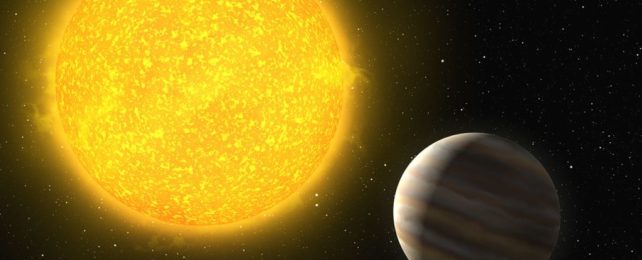When it comes to finding life on other planets, a warm, wet world bubbling with a complex soup of chemicals might not be enough. It could pay to have the right kinds of planets in the neighborhood as well.
An intriguing pair of gas giants has been found orbiting a star so similar to the Sun it could practically be its twin, and it could teach us a thing or two about solar systems like ours.
Located just 175 light-years away, the star HIP 104045 appears to have at least two large worlds whizzing around it – one about half the mass of Jupiter on a 6.3-year orbit, and the other about 2.5 times the mass of Neptune on 316-day orbit.
This discovery, submitted to the Monthly Notices of the Royal Astronomical Society and available on preprint server arXiv, is helping us understand the variety of systems that can orbit Sun-like stars, in the hopes of finally finding a second Earth.
As the one place in the Universe known to develop a biosphere, Earth is our only blueprint for the conditions necessarily for life. But Earth doesn't exist in isolation; it has an entire planetary system around it, with seven other planets, countless asteroids and dwarf planets, and our star, the Sun.
Recent studies suggest that the architecture of a planetary system plays an important role in the habitability of a planet in Earth's situation. The presence of asteroids and comets that can deliver certain ingredients to a planet is pretty important.
It also seems that Jupiter plays a significant role: it protects the inner Solar System from constant bombardment from small rocks, shepherding both the asteroid belt and the asteroids that share its orbit. But its immense gravity can also disrupt the orbits of those smaller bodies, flinging them towards the inner Solar System. Early in the system's history, Jupiter was likely instrumental in helping those rocks reach Earth.
If we want to whittle down our options on where to look for life, we could do worse than looking for planets similar to Jupiter for other reasons, too.
"Jupiter analogues form preferentially around stars with metallicities close to solar, and strikingly, potentially habitable low-mass planets could be common around stars that host a cold Jupiter," writes an international team of astronomers led by Thiago Ferreira of the University of Sao Paulo in Brazil.
"Small Earth-sized planets are more common than giant planets. These factors open precedents to the search for Earth-like planets around Sun-like stars by primarily looking for Jupiter-like planets."
Since 2014, astronomers have been using the High Accuracy Radial velocity Planet Searcher (HARPS) at the European Southern Observatory's La Silla 3.6 meter telescope in the Chilean Atacama Desert to search for planets around stars that are similar to the Sun.
On paper, HIP 104045 is a near-perfect match. Its metal content is very similar to that of the Sun's. It's around 4.5 billion years old; the Sun is 4.57 billion years old. HIP 104045 is just 1.03 times the Sun's mass, 1.05 times the Sun's radius, and has 1.11 times the luminosity of the Sun.
When Ferreira and his colleagues analyzed the light from HIP 104045, they found evidence of not one world, but two.
The first world, at 0.498 times the mass of Jupiter, is what is known as a Jupiter analogue: an exoplanet between 0.3 and 3 times the mass of Jupiter, with an orbit between 3 and 7 AU from star, making it likely to play a dynamical role similar to that of Jupiter in our own Solar System.
The second exoplanet is a super-Neptune. Where our own Neptune is 17 Earth masses, this discovery weighs in at around 43 times the mass of Earth. Since the upper limit for rocky worlds is thought to be around 10 Earth masses, the planet is unlikely to be a terrestrial world like ours, but instead rather gaseous in nature.
But it is in what is known as the optimistic habitable zone, at least. The habitable zone is the distance range from the host star that is within a temperature range for liquid water; the optimistic habitable zone is a wider distance range in which habitable temperatures are possible, but you might be slightly pushing your luck.
Just don't get your hopes up. The planet doesn't pass between us and its star, so we currently have no way of analyzing its atmosphere for biosignatures.
Could there still be a small, rocky world orbiting HIP 104045 brimming with alien goo? Though we might hope the discovery of a Jupiter analogue suggests an Earth-like world is hiding nearby, that super-Neptune orbiting relatively close to the star pours cold water on that idea.
The presence of the super-Neptune, the team says, is just one more reason to think our own Solar System is indeed atypical, with similar systems to ours occurring around perhaps 1 percent of Sun-like stars.
Of course, we don't even have close to enough information yet. There are a lot of stars out there. So we're just going to keep looking.
The team's research has been submitted to the Monthly Notices of the Royal Astronomical Society, and is available on arXiv.
